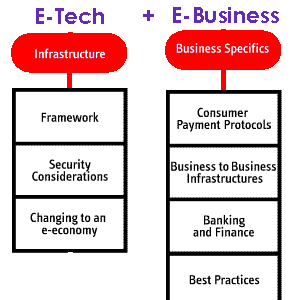|
E-Commerce

E-Commerce:
- Electronic-based Commerce
- Typically, over Internet, mostly Web-based
- Advantages:
- Instant or fast distribution
- Order directly from factory, traditional stores not necessary....potential
reduction in cost
- 24/7 - open anytime
- Access anywhere
- Sell not just products but, services and soft goods (e.g.
software, newsletters, reports, etc)
- Global marketplace
- B2B and B2C opportunities
- Help Company Infrastructure
- inventory monitoring
- sales tracking
- automated customer support
- Challenges:
- Profitable Business Models
- Logistics (shipping, returns, etc)
- Competing with strong "old-economy" businesses
|
Challenges
- Developing sustainable/profitable business model.
- Meeting needs of extremely fast-paced changing market.
- Keeping up with technology changes.
- Handling changing bandwidth issues.
- Dealing effectively with Security issues
- Dealing effectively with Logistics (delivery,etc.)
|
History:
- Many transaction models based on older Financial Transactions
over networks.
- EFT= Electronic Fund Transfer (early 1970s). Banks
use to transfer sums of money between each other over secure
private networks. (Same basic technology is used for ATM)
- EDI = Electronic Data Interchange (late 1970s). Used
to allow businesses to exchange documents. Example order forms
between suppliers and customers. Again used privately maintained
networks.
- Problem: different companies implemented different variations
of EDI...problems with compatibility.
- Email: Electronic Mail. Used by businesses again to
send and recieve information and documents. (became widely used
in mid 1980s.).
- Internet becomes public-access for commerce transactions
around 1991
- driven by official standard TCP/IP....issues of compatibility
not there.
- WWW booms mid 1990s.
|
Some Terms and Definitions:
eEnterprise
- is an enterprise with the capability to exchange value (money,
goods, services and information) electronically.
eEconomy
- is the broader business environment in which global eCommerce
is conducted.
EDI
- Electronic Data Interchange, the transfer of data beween different
companies using networks, such as the Internet. As more and more
companies get connected to the Internet, EDI is becoming increasingly
important as an easy mechanism for companies to buy, sell, and
trade information. ANSI has approved a set of EDI standards known
as the X12 standards.
Digital Cash
- A system that allows a person to pay for goods or services by
transmitting a number from one computer to another. Like the serial
numbers on real dollar bills, the digital cash numbers are unique.
Each one is issued by a bank and represents a specified sum of
real money. One of the key features of digital cash is that, like
real cash, it is anonymous and reusable. That is, when a digital
cash amount is sent from a buyer to a vendor, there is no way
to obtain information about the buyer. This is one of the key
differences between digital cash and credit card systems. Another
key difference is that a digital cash certificate can be reused.
There a number of competing protocols, and it is unclear which
ones will become dominant. Most digital cash systems start with
a participating bank that issues cash numbers or other unique
identifiers that carry a given value, such as five dollars. To
obtain such a certificate, you must have an account at the bank;
when you purchase digital cash certificates, the money is withdrawn
from your account. You transfer the certificate to the vendor
to pay for a product or service, and the vendor deposits the cash
number in any participating bank or retransmits it to another
vendor. For large purchases, the vendor can check the validity
of a cash number by contacting the issuing bank.
|
Traditional Sales Cycle:
- Design New Product(s)
- Market New Product(s)
- Distribute Product(s)
- Provide Customer Support
|
Important Issues:
- Intelligent Tracking -
Just knowing the number of visitors to your website isn't
good enough, understanding what visitors are doing on your
website is critical to your ongoing success. Employ technology
that will help in smarter decision-making such as marketing
tools like Coremetrics, Ad Relevance, and WebTrends.
- Affiliate Networks
By sharing a percentage of a sale or offering a cost-per-lead,
companies can enjoy ad placements that produce sales at a
low fixed cost by building an affiliate network. By teaming
up with affiliate technology providers such as BeFree, Linkshare,
and Commission Junction, for example, companies are realizing
a decrease in customer acquisition cost and increased brand
reach.
|
New Payment Options:
|
Portals
A Web site or service that offers a broad array of resources
and services, such as e-mail, forums, search engines, and on-line
shopping malls.
|
StoreFront Builders
Tools or agencies that help business's build e-Commerce storefronts.
|
Auction Builders
Tools or agencies that help build auction sites.
|
|
